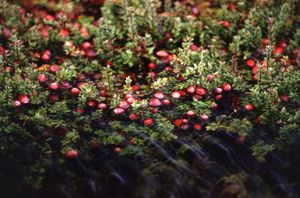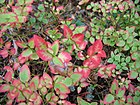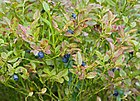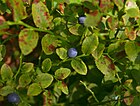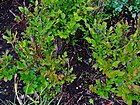Note: This is a project under development. The articles on this wiki are just being initiated and broadly incomplete. You can Help creating new pages.
Vaccinium - Karamarda
Cranberries are a group of evergreen dwarf shrubs or trailing vines in the subgenus Oxycoccus of the genus Vaccinium.
Uses
Lower blood pressure, Diabetes, Hemorrhoids, Varicose veins, Angina, Cancer, Kidney stones, Diarrhea, Blood pressure
Parts Used
Chemical Composition
It contains chrysoeriol, scopoletin, trans-p-hydroxycinnamic acid, trans-p-hydroxycinnamic acid ethyl ester, cafeic acid ethyl ester, beta-sitosterol, iuteolin, quercetin, esculetin , cafeic acid, isolariciresinol-9-O-beta-D-xyloside, 10-O-trans-p-coumaroylsandoside[1]
Common names
| Language | Common name |
|---|---|
| Kannada | Anduvan |
| Hindi | |
| Malayalam | Kelamaram |
| Tamil | Anduvan |
| Telugu | |
| Marathi | NA |
| Gujarathi | NA |
| Punjabi | NA |
| Kashmiri | NA |
| Sanskrit | |
| English | Indian Cranberry |
Properties
Reference: Dravya - Substance, Rasa - Taste, Guna - Qualities, Veerya - Potency, Vipaka - Post-digesion effect, Karma - Pharmacological activity, Prabhava - Therepeutics.
Dravya
Rasa
Tikta (Bitter), Kashaya (Astringent)
Guna
Laghu (Light), Ruksha (Dry), Tikshna (Sharp)
Veerya
Ushna (Hot)
Vipaka
Katu (Pungent)
Karma
Kapha, Vata
Prabhava
Habit
Identification
Leaf
| Kind | Shape | Feature |
|---|---|---|
| Simple | The leaves are ovate, in an irregular oval or slightly egg shape that is wider at the bottom than the top |
Flower
| Type | Size | Color and composition | Stamen | More information |
|---|---|---|---|---|
| Unisexual | 0.33" long | White to very light pink | 5-20 | Blooms are typically numerous and somewhat showy and Bloom time is May |
Fruit
| Type | Size | Mass | Appearance | Seeds | More information |
|---|---|---|---|---|---|
| Blue-black berry | 0.25" to 0.5" diameter | Eaten readily by wildlife and humans | Ripen July through August | 1 | {{{6}}} |
Other features
List of Ayurvedic medicine in which the herb is used
Where to get the saplings
Mode of Propagation
How to plant/cultivate
Landscape Uses: Border, Massing, Seashore. Requires a moist but freely-draining lime free soil, preferring one that is rich in peat or a light loamy soil with added leaf-mould[3]
Commonly seen growing in areas
Photo Gallery
References
External Links
- Ayurvedic Herbs known to be helpful to treat Lower blood pressure
- Ayurvedic Herbs known to be helpful to treat Diabetes
- Ayurvedic Herbs known to be helpful to treat Hemorrhoids
- Ayurvedic Herbs known to be helpful to treat Varicose veins
- Ayurvedic Herbs known to be helpful to treat Angina
- Ayurvedic Herbs known to be helpful to treat Cancer
- Ayurvedic Herbs known to be helpful to treat Kidney stones
- Ayurvedic Herbs known to be helpful to treat Diarrhea
- Ayurvedic Herbs known to be helpful to treat Blood pressure
- Herbs with Fruits used in medicine
- Herbs with Leaves used in medicine
- Herbs with common name in Kannada
- Herbs with common name in Malayalam
- Herbs with common name in Tamil
- Herbs with common name in English
- Habit - Deciduous Shrub
- Index of Plants which can be propagated by Seeds
- Herbs that are commonly seen in the region of Swamps
- Herbs that are commonly seen in the region of Low wet woods
- Herbs that are commonly seen in the region of Pine barrens
- Herbs that are commonly seen in the region of Dry uplands
- Herbs
- Ericaceae
